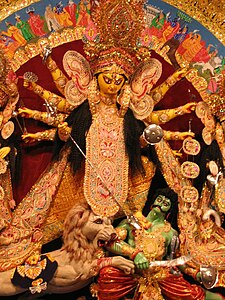lalita devi, lalitha tripura sundari, goddess lalita devi wallpapers, lalita the seduction goddess, Thirai Sundari devi, Lalita goddess, goddess lalita devi, goddess lalita, tripura sundri lords wallpaper, shri lalitha tripurasundari

Goddess Lalita or Lalitha Tripura Sundari devi and the red Goddess, is one of the most powerful manifestations of Goddess Shakti. Goddess Shakti incarnated as Lalita to demolish the demon called Bhandasura. Bhandasura was a demon formed from the ashes of Manmadha or Kama deva, the God of Love and seduction.
Legend of Lalita avatara – Significance of Lalitha Tripura Sundari incarnation:
When Lord Shiva was performing severe Tapas (penance), Manmadha tried to disturb him by aiming the arrows of seduction. Lord Shiva was disturbed greatly and with a deep anger opened his third eye and destroyed Manmadha into ashes. Shiva Gana Sevaks collected the ashes of Kama Deva and drew a portrait of a man. With a single glance of Lord Shiva on that portrait of ashes, it came alive. As we know, Lord Shiva is called as Bhola Shankar, blessed the live form of the ashes, which became demon called Bhandasura.
Blessed by Lord Shiva, Bhandasura started to show his real characteristics of a demon. He harassed Sadhus (saints) and occupied all the lokas including Swarga Loka (the Heaven). To get rid of demon Bhanda, Lord Indra (the King of Gods and Swarga Adhipathi) observed a Yagna (sacrifice) to please the Mother Goddess. Pleased with Indras Yagna, Goddess Shakti appeared as Sri Lalitha Devi sitting on Sri Chakra.
Sri Lalitha Devi demolished the demon Bhandasura and his original form of Manmadha or Kama was restored. The whole episode of Lalita and Bhandasura is explained as ‘Bhandasura Vadha in Puranas.
Importance of Lalita Tripura Sundari:
Goddess Lalita represents the Panchabhuta (five basic elements) of the Universe. Panchabhutas are – air, water, fire, earth and space (Vayu, Jala, Agni, Bhumi and Akasha). Lalitha Devi is also associated with Sri Chakra, the ultimate Chakra representing the origin and existence of the universe.

 Depiction of Durga at Maddox Square, Kolkata; also referred to as Durgotsab
Depiction of Durga at Maddox Square, Kolkata; also referred to as Durgotsab
 Goddess Brahmacharini Mata - Second Navadurga
Goddess Brahmacharini Mata - Second Navadurga
 Around 150,000 laddus are made daily.
Around 150,000 laddus are made daily. Lord Ganesha continues to be the most popular Hindu God when it comes to body tattoos. ‘Om’ or Aum’ is the most favorite symbol. Other popular Hindu gods employed in tattoos include Shiva, Goddess Lakshmi, Saraswathi, Hanuman, Vishnu, Krishna, Durga, Kali and very rarely Lord Vishnu in Anantha Shayanam form (Lying on five-headed snake Anantha in the Ocean). Among symbols after the ‘OM’ symbol, it is the trident of Shiva and Sanskrit verses or Sanskrit letters. There are also people who opt for the Swastika symbol and rarely the Poorna Kumbha symbol.
Lord Ganesha continues to be the most popular Hindu God when it comes to body tattoos. ‘Om’ or Aum’ is the most favorite symbol. Other popular Hindu gods employed in tattoos include Shiva, Goddess Lakshmi, Saraswathi, Hanuman, Vishnu, Krishna, Durga, Kali and very rarely Lord Vishnu in Anantha Shayanam form (Lying on five-headed snake Anantha in the Ocean). Among symbols after the ‘OM’ symbol, it is the trident of Shiva and Sanskrit verses or Sanskrit letters. There are also people who opt for the Swastika symbol and rarely the Poorna Kumbha symbol. India has a strong tradition of tattoo drawing especially in the rural regions. But the tradition was limited mostly to simple drawings, writing names of one’s favorite god or lover in local languages.
India has a strong tradition of tattoo drawing especially in the rural regions. But the tradition was limited mostly to simple drawings, writing names of one’s favorite god or lover in local languages. Interestingly, it is not Hindus who are interested in the Hindu tattoos. This is understandable as many Hindus would not prefer tattoos of Hindu Gods on their body. And some Hindus might find it an insult of their culture.
Interestingly, it is not Hindus who are interested in the Hindu tattoos. This is understandable as many Hindus would not prefer tattoos of Hindu Gods on their body. And some Hindus might find it an insult of their culture. Shiva and Shakti are main gods in Tantrism. They are a symbol and represent the male and female. Some Tantric texts are conversations between Shiva and Shakti.
Shiva and Shakti are main gods in Tantrism. They are a symbol and represent the male and female. Some Tantric texts are conversations between Shiva and Shakti. 







